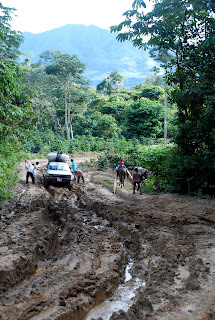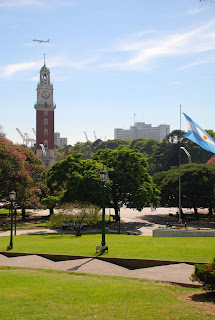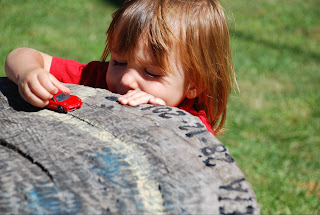Revising children’s teeth in the town of Calzada with the local health center’s dentist.
In a city school, some classrooms had space for children to practice oral hygiene.
It is easier to interest the kids sitting towards the front. I hope the kids farther aren’t left without some oral health knowledge.
The kids in Llullucucha (my home neighborhood) were eager to take pictures.
Francis, my host sister, takes on the role of S. mutans in a Llullucucha classroom.
Charlas for the Salud Bocal (oral health) project:
Staying in the city this week to work at the clinic, Ivet and I visited several elementary schools to give charlas (short presentations/lessons) on oral health. In some schools, I simply drew a tooth on the board. To others, we brought along the attempted tooth model (I am am fully convinced that it is not an architectural success as it doesn't support itself very well, and I am not sure if it is an esthetic or instructional success as we don't get 100% recognition when we ask what the structure is). Kids have called the tooth a cow, elephant, horse, and piñata...but most later agree that it is really a representation of a tooth. I usually start the charla by pointing out some tooth anatomy (identifying the crown/roots and enamel, dentin, pulp) and then introduce the star of the show, tooth-dwelling Streptococcus mutans, named S. mutans for short. I explain that much like them, the bacteria enjoy sweet foods. They multiply and produces lots of acid when fed such items as soda, chocolate, cookies, etc; the acid, then, nibbles away at the enamel, forming many little holes when it breaks down. "Washing away" the acid with healthy drinks like water or milk, I ask how we can we remove the placa (the groups of bacteria adhered to the tooth). Most classes eventually suggest a toothbrush and we practice brushing in circles or up and down on our cheeks. Introducing (or prompting to remember the other way to clean teeth) floss, I demonstrate how to encircle each tooth like the letter 'c' and move the floss up and down gently on each tooth's side. Although these two methods remove most of the bacteria, one or two are left, as they always live on our teeth. In some classes, I explain that dentists may place a cream, foam, or paint on their teeth to repair the small holes while they are small (fluoride). Going towards the climax of the drama, I ask what happens if they eat sweet things and don't clean their teeth, reviewing the bacteria-plaque-acid-enamel decomposition cascade. The many 'little holes,' I explain, become a large, often stained, hole called a caries. If it is deep enough to enter la dentina, close to la pulpa, the cavity will produce pain. At this point, I tell the children, we need help to take care of our teeth from a doctor. I show them that a dentist cleans the cavity and all the bacteria and acid and 'cures' the cavity with special material, making our teeth healthy again (without the infection). Putting dentists in such a positive light, I end the 'drama.'
When introducing the word cavity, the children are often eager to point out who has cavities in the class. When asked if they have ever had tooth pain, nearly all children raise their hand, testifying that the pain is feo, or ugly. After explaining the importance of asking a dentist's help while the cavity is small (so as not to extract the tooth when the cavity grows too large to repair), we review tooth brushing/flossing and questions are taken. In one class, a young boy earnestly inquired about how the bacteria stick themselves to our teeth. I did my best to compare the stickiness of tape to a substance that the bacteria produce, not wanting to confuse the sugar matrix that plaque uses with what the bacteria eat. One of the instructors asked for clarification about drinking milk to clean teeth; he wasn't convinced that it did. I explained that milk helps wash away the enamel-harmful acids, while the bacteria remain and can 'eat' the milk to produce more acids and therefore must be brushed/flossed away.
We usually accompany a dentist who checks the chidren's teeth to encourage them to use their social health coverage to receive free treatments. At one school, I had the opportunity to hold a flashlight while the dentist conducted these revisions. Of the 40 children whose teeth were checked, only two or three had no cavities. This makes me wonder if socialized health care or free healthcare solves the problem of oral neglect (in the States and abroad). Sheer education and motivation also seems to be lacking...perhaps being the foremost 'problems' before insurance and financing become relevant concerns. In a rural town (not a village but not quite a city) school, I was puzzled to see various facial scars on a handful of the children's faces. When the dentist discussed their treatment plan, we found that many of the children live with their grandparents, aunt, or brother. One of the instructors explained to Ivet that most of the children come from abusive and broken families. The professora wishes that she could get at least psychological support from San Lucas or another organization--she often worries for the children's mental and emotional states. Several students casually commented to Ivet on being illegitimate children, being 'fought over' by grandparents and parents, or their parent's marital problems. In the complex lives of these children, I wonder what priority oral health or even treatment of oral disease takes. What is one's duty as a 'dental health proffessional' in such instances...as a human being?
I hope I will get the chance to visit schools in the US as a dentist. I think I would enjoy holding 'oral health workshops' to teach kids about teeth and oral hygiene. Moreover, it seems worthwhile to me to spend time revising each child's teeth to identify needs but more importantly to provide what some call 'a positive experience' (what I'd call simply a human experience) to instil motivation in children to seek dental services freely in their future. ...dream on, Luba (my Spanish/Russian short name), that's the only way you'll get anywhere (as far as my experience has led me to believe)!
Ivet and I visited Nuevo Jerusalen, a community in which the clinic has completed 3 year development. Dscf5131
Starting out the trip to Nueva York in Moyobamba, the truck is loaded (inside and out)—feeling closterphobic? But packing things and people so tightly helps keep one in place when jostled around up the mountain.
We meet the sunrise halfway between two villages.
In Nueva York, a one-classroom schoolhouse hears out my charla.
We practice brushing in circles and up and down with their gifted tooth brushes.
A young girl is freshly bathedand ready for the village meeting that Ivet leads to initiate community development in Nueva York.
A gentleman wearing his llanques--the typical footwear in the Sierra region of Peru, made exclusively from recycled tires.
The sun begins to set as we begin a discussion with the authorities, after dismissing the villagers.































































